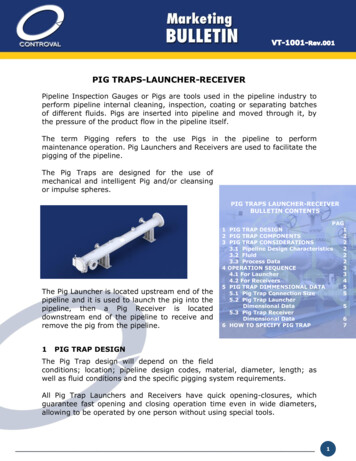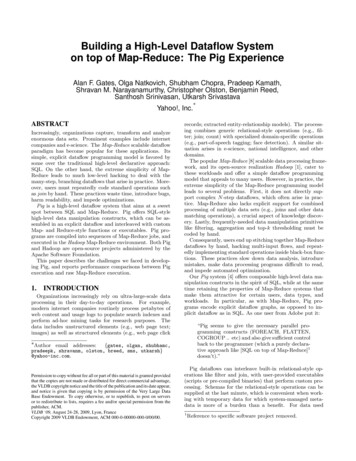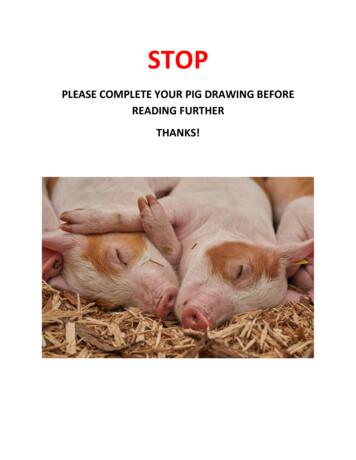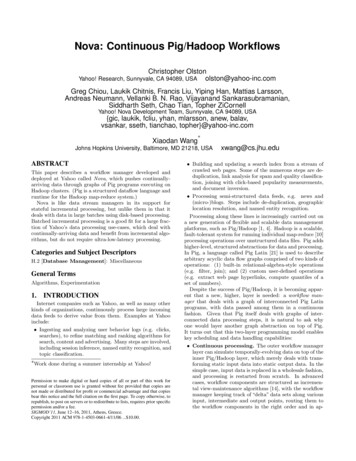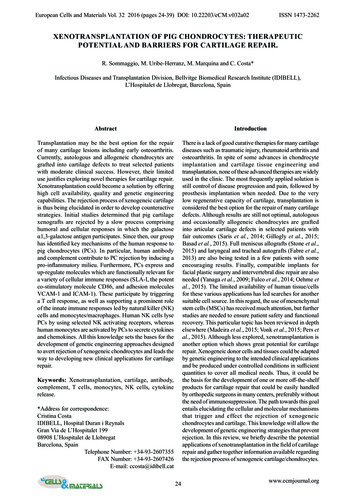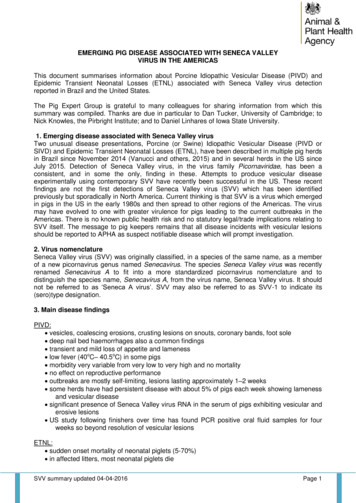
Transcription
EMERGING PIG DISEASE ASSOCIATED WITH SENECA VALLEYVIRUS IN THE AMERICASThis document summarises information about Porcine Idiopathic Vesicular Disease (PIVD) andEpidemic Transient Neonatal Losses (ETNL) associated with Seneca Valley virus detectionreported in Brazil and the United States.The Pig Expert Group is grateful to many colleagues for sharing information from which thissummary was compiled. Thanks are due in particular to Dan Tucker, University of Cambridge; toNick Knowles, the Pirbright Institute; and to Daniel Linhares of Iowa State University.1. Emerging disease associated with Seneca Valley virusTwo unusual disease presentations, Porcine (or Swine) Idiopathic Vesicular Disease (PIVD orSIVD) and Epidemic Transient Neonatal Losses (ETNL), have been described in multiple pig herdsin Brazil since November 2014 (Vanucci and others, 2015) and in several herds in the US sinceJuly 2015. Detection of Seneca Valley virus, in the virus family Picornaviridae, has been aconsistent, and in some the only, finding in these. Attempts to produce vesicular diseaseexperimentally using contemporary SVV have recently been successful in the US. These recentfindings are not the first detections of Seneca Valley virus (SVV) which has been identifiedpreviously but sporadically in North America. Current thinking is that SVV is a virus which emergedin pigs in the US in the early 1980s and then spread to other regions of the Americas. The virusmay have evolved to one with greater virulence for pigs leading to the current outbreaks in theAmericas. There is no known public health risk and no statutory legal/trade implications relating toSVV itself. The message to pig keepers remains that all disease incidents with vesicular lesionsshould be reported to APHA as suspect notifiable disease which will prompt investigation.2. Virus nomenclatureSeneca Valley virus (SVV) was originally classified, in a species of the same name, as a memberof a new picornavirus genus named Senecavirus. The species Seneca Valley virus was recentlyrenamed Senecavirus A to fit into a more standardized picornavirus nomenclature and todistinguish the species name, Senecavirus A, from the virus name, Seneca Valley virus. It shouldnot be referred to as ‘Seneca A virus’. SVV may also be referred to as SVV-1 to indicate its(sero)type designation.3. Main disease findingsPIVD: vesicles, coalescing erosions, crusting lesions on snouts, coronary bands, foot sole deep nail bed haemorrhages also a common findings transient and mild loss of appetite and lameness low fever (40oC– 40.5oC) in some pigs morbidity very variable from very low to very high and no mortality no effect on reproductive performance outbreaks are mostly self-limiting, lesions lasting approximately 1–2 weeks some herds have had persistent disease with about 5% of pigs each week showing lamenessand vesicular disease significant presence of Seneca Valley virus RNA in the serum of pigs exhibiting vesicular anderosive lesions US study following finishers over time has found PCR positive oral fluid samples for fourweeks so beyond resolution of vesicular lesionsETNL: sudden onset mortality of neonatal piglets (5-70%) in affected litters, most neonatal piglets dieSVV summary updated 04-04-2016Page 1
most deaths occur 0-3 days old, up to 7-days-old may die or waste, older piglets unaffected deaths rapid (5-6 hours), not starvation – stomachs contain milk sometimes concurrent lethargy, neurological signs and/or diarrhoea in neonatal piglets surviving piglets in herds affected with piglet mortality rarely show vesicles, sows may outbreaks are self-limiting, lasting approximately 1–2 weeks PCR detection of SVV in lung, heart, liver, spleen, kidney and intestine of piglets from ETNLoutbreaks but no pathology to explain deaths US study following unaffected and affected litters has found SVV in sows and piglets in bothThe two age-related disease presentations described have occurred together on breeding unitswith PIVD in sows preceding piglet mortality due to ETNL in a recent US case, while in Brazil,ETNL cases preceded reports of PIVD in sows, possibly because the vesicles were mild andoverlooked.4. Experimental infectionIn October 2015, the USDA and Iowa State University reproduced vesicular disease (classiclesions on snout, oral cavity and feet) by experimental infection of growing pigs in a studyconducted by Dr Kelly Lager’s group (USDA, Ames, IA - USA) using a contemporary 2015 USSVV field isolate from Dr KJ Yoon (Iowa State University, Ames, IA - USA). The findings wereshared at the Swine Disease for Practitioners Conference at Iowa State University in November,2015. The field isolate was from a case which had been investigated by animal health officials andnotifiable vesicular diseases had been ruled out by testing.5. Impact of diseaseThe main impact relates to the fact that the PIVD lesions closely resemble notifiable vesiculardiseases (FMD, SVD, VS). Incidents have been reported to the Animal Health authorities and theinvestigations have required testing to rule out classical vesicular disease. This is costly anddisruptive to the AH authorities and pig industry, especially when vesicles are detected atabattoirs. There is concern in Brazil that this PIVD could result in complacency with respect toreporting vesicular disease as suspect notifiable disease. The recommendation is that all diseaseincidents with any vesicular lesions present should be reported and trigger notifiable diseaseinvestigations.There is minimal production loss in pigs affected with PIVD as it is clinically mild and of shortduration, although lameness can cause concern if lesions become secondarily infected. The pigletmortality in ETNL is clearly a loss but is also very transient and only affects piglets up to one weekold. There are no reports of repeat outbreaks in affected herds in Brazil so far.In Brazil, up to 80% of the industry is estimated to have been affected between October 2014 andMarch 2015 with rapid spread across the country (SE to Midwest to South) into six states in threegeographical regions (Leme and other, 2015 and Vannucci and other, 2015). The rapidemergence of SVV in Brazil suggests that infection was introduced into a naïve national herd.In the US, from July to early November 2015, Seneca Valley virus has been detected in around100 pig herds; around 38 breeding farms and 30 farms with growing pigs, rest unknown. Bothcommercial and exhibition/show pigs have been affected. These were investigated and negatedby testing for notifiable vesicular diseases. There has been a sharp decline in SVV outbreakssince November 2015 in the US. Seroprevalence studies are still to be undertaken when anELISA has been validated, it is suspected that SVV may be endemic in some areas of the US.6. Spread of diseaseThe routes of transmission between herds and pigs are still unknown but there have not beenobvious links with pig or semen sources and indirect virus transmission is considered to have beeninvolved in spread of infection. Preliminary data from Brazil on risk factors show:Positively associated factors: Neighbouring farm with ETNL, cattle nearby to unit, pelleted feed,bovine or swine plasma in feed (bovine had higher odds), some specific vaccines.SVV summary updated 04-04-2016Page 2
Not associated: feed company, source of corn, genetics, gilt source (internal external), equipmentsharing, blood/bone meal in feed, water source, perimeter fencing, semen source.There is limited published data and many uncertainties including routes and period of virusexcretion, whether carrier status exists, the role of non-porcine hosts, virus survival etc. Samplesfrom field studies have detected virus in oral fluids for at least four weeks from start of outbreakand beyond resolution of vesicular lesions. Virus has been detected in one boar’s semen for amonth in a field outbreak.As the virus is a member of the Picornaviradae family of non-enveloped single-stranded RNAviruses (of which foot-and-mouth disease viruses, polioviruses and rhinoviruses are also members)it is likely to be relatively environmentally stable. Excretion of these viruses occurs in faeces, salivaand the presence of a viraemic stage means that blood, meat and meat products and otherproducts of animal origin may be a source of virus with transmission pathways relating to ingestionor inhalation of these secretions, excretions or products, or to fomites contaminated with them.Therefore, although there are no proven transmission routes for Seneca Valley virus, a range oftransmission pathways should be considered until further evidence is available. In addition, as thelesions in clinical disease involve the skin and feet, and there is a viraemic stage, mechanicaltransmission by vectors such as biting flies cannot be ruled out. A preliminary outbreakassessment identifying potential risk pathways for entry of SVV into the UK has recently beenpublished by the International Disease Monitoring Team in APHA and is available on this uploads/attachment data/file/510872/poa-senecaamerica.pdf7. Virology and testingKnowles and others (AASV) characterised an unknown picornavirus isolate from US pigs from1988 and were also provided with a sequence of a cell culture contaminant and found both to be anovel virus, named Seneca Valley virus (or Senecavirus A) . They also studied SVV isolates frompigs with and without vesicular lesions in different US states in subsequent years, all of whichappeared to belong to the same genetic lineage suggesting recent emergence in US pigs in theearly 1980s. Initial sequence analysis suggests that a strain of Seneca Valley virus has recentlyemerged in Brazil and similar contemporary strains have recently been detected in the US with98.6 to 100% similarity. There is lower similarity (86.7 to 90.5%) between the Seneca Valley virusfrom current cases and previous Seneca Valley virus detected in pigs in the US and Canada inprevious years, consistent with the evolution of a highly mutable RNA virus. Recent retrospectivePCR screening of samples at the veterinary diagnostic laboratories at the Universities of Minnesotaand Iowa has detected Seneca Valley virus in samples from a small number of herds (1.2% cases,0.45% samples) in three US States, these herds did not have vesicular lesions evident. This pointsto low level circulation of virus. Retrospective investigation of material stored from sporadic,previously undiagnosed US cases of PIVD and ENTL dating back to the 1990s, has indicatedpresence of Seneca Valley virus in some. Further analysis is in progress to investigate the geneticdiversity and evolution of Seneca Valley virus.An ELISA is being validated now that experimental positive sera are available – seroprevalencestudies can then be undertaken.No virological or serological testing for Seneca Valley virus has been performed on pigs in the UKbut it is considered that the national herd is likely to be naïve. The most likely alert to the presenceof the vesicular disease manifestation in GB would be a report case to APHA of suspect notifiablevesicular disease in pigs as occurred in both Brazil and the US. It is highly likely that testing atPirbright would then be required to negate notifiable vesicular disease. This provides theopportunity for submitted material to be tested for Seneca Valley virus at Pirbright once negated fornotifiable disease. No notifiable disease investigations fitting the description of PIVD have beenreported to APHA field services from 2014 to date.SVV summary updated 04-04-2016Page 3
An RT-PCR for Seneca Valley virus is being used in Brazil and the US. Serological tests beingused in the US at present are reportedly not yet fully reliable.8. Global and GB statusThese disease manifestations associated with Seneca Valley virus detection have only beenreported in Brazil and North America to date. Sporadic PIVD has been described in Australia, Italyand New Zealand but Seneca Valley virus was not investigated. There was reference in Leme andothers (2015) to a 2007 vesicular disease investigation in pigs in Northern Ireland however thefeatures of this incident provided by DARD do not raise any suspicion of possible PIVD.No testing for Seneca Valley virus has been performed on pigs in the UK. No recent vesiculardisease reports have been made to suggest that PIVD due to SVV is present or emerging. Notesting of archived tissues or sera has been undertaken to determine if there is exposure to nondisease associated SVV in UK pigs.If ETNL associated with Seneca Valley virus were to occur in GB, unless PIVD was seenconcurrently, it may be not be investigated by farmers if mortality was low especially as it istransient and affects neonatal piglets. The higher the mortality, the more likely it would be forpiglets to be submitted to APHA, SAC CVS, or external post-mortem providers for diagnosticinvestigation. The absence of gross and microscopic pathological findings means that these mayresult in being undiagnosed cases of systemic, enteric or nervous syndrome with clinical signs offound dead, diarrhoea or nervous disease being most likely. Diagnosis not reached (DNR) analysisof submissions with these presenting signs, and for systemic, enteric and nervous syndromes inneonatal piglets for the first nine months of 2015 showed that there were no statistically significantincreases or incidents of concern.9. Host rangea) Humans - the virus can infect humans but is considered harmless. In 2002, it was found as acontaminant in tissue culture, then found to be able to infect human cells in tissue culture, thenfound to be oncolytic so has been looked into as a tumour treatment (Burke and others, 2015).When inoculated into humans it is harmless, they seroconvert and become virus negative followingviraemia and (in some) faecal excretion (Burke and others, 2015), the virus targets and replicatesin tumour cells. Knowles and others (AASV) report limited serological analyses in the generalhuman population and farmers which showed only one to have low level neutralizing antibody toSeneca Valley virus. Koppers‐Lalic and others (2011) refer to this as evidence that exposure toSeneca Valley virus is not prevalent in the human population and is classified as a non-humanvirus not considered to be naturally infecting humans. The Human Animal Infections and RiskSurveillance (HAIRS) Group have been made aware of SVV in the Americas and have confirmedthat SVV is not used in the UK for treatment of humans, If UK patients were enrolled in studies, thetreatment would take place in US and in the studies done, one would not expect viral excretion infaeces on their return to UK.b) Cattle - there is historical serological evidence reported of Seneca Valley virus infection in cattlein the US (Knowles and others, AASV). Also two risk factors identified for affected pig farms inBrazil were farms being close to cattle and bovine plasma in feed. The detection of Seneca Valleyvirus in 2002 as a cell culture contaminant was presumed to have been through introduction inbovine serum or porcine trypsin. There has been no increase in vesicular disease reports in cattlein Brazil or US indicating that if cattle are involved in virus transmission or acting as a virusreservoir, it is not causing disease in them. The APHA Cattle Expert Group has been made aware.c) Rodents – seropositivity in rodents is reported. Koppers‐Lalic and others (2011) refer to a studyin mice which showed no evidence of horizontal transmission from mice injected with SVV andmixed with naïve mice. The closest evolutionary relatives to Seneca Valley virus are cardioviruses,which are principally rodent viruses.SVV summary updated 04-04-2016Page 4
d) Other - Further information about non-porcine hosts may come out of Brazilian and US studieson affected farms.10. Knowledge gaps.Investigations in the US continue into SVV infections in pigs and the epidemiology of the diseaseto address the many uncertainties including routes and period of virus excretion, whether carrierstatus exists, the role of non-porcine hosts, virus survival etc. Research is being commissioned inthe US to address the key gaps in knowledge and includes: Confirmation of Seneca Valley virus as causal agent of ETNL and VS by challenge studies.Characterise Seneca Valley virus from diseased and non-diseased farmsDevelopment and validation of molecular and antibody-detection diagnostic tools.Describe population and individual infection dynamics (shedding duration and route)Perform epidemiological studies on regional prevalence and distribution.Evaluate the stability of Seneca Valley virus in disinfectants and the environment.Study the prevalence of Seneca Valley virus in other significant hosts and products.Conduct outbreak investigations including environmental and potential vector testing11. ReferencesAASV website ases/SenecaValleyVirus.phpAPHA (2016), Preliminary Outbreak Assessment: Senecavirus A in the em/uploads/attachment data/file/510872/poa-senecaamerica.pdfBurke, M. J. and others, Pediatr Blood Cancer 2015;62:743–750Knowles N. J., Laura M. Hales, Brian H. Jones, John G. Landgraf, James A. House, Kristine L.Skele, Kevin D. Burroughs and Paul L. Hallenbeck https://www.aasv.org/SVV/SVVUS.pdfKoppers‐Lalic D. and Rob C. Hoeben, Rev. Med. Virol. 2011; 21: 227–239.Published online 11 May 2011 in Wiley Online Library Reviews in Medical Virology DOI:10.1002/rmv.694Leme, R.A., E. Zotti, B. K. Alcantara, M. V. Oliveira, L. A. Freitas, A. F. Alfieri and A. A. Alfieri(2015). Senecavirus A: An Emerging Vesicular Infection in Brazilian Pig Herds. Transboundary andEmerging Diseases doi:10.1111/tbed.12430Pasma, T., Davidson, S. and Shaw, S.L. (2008) Idiopathic vesicular disease in swine in Manitoba.Canadian Veterinary Journal 49: 84-85Singh, K., Corner, S., Clark, S.G., Scherba, G. and Fredrickson, R. (2012) Seneca Valley virus andvesicular lesions in pig with idiopathic vesicular disease. J. Vet. Sci. technol. 3: 123US information: ation/Vannucci, F.A., D. C. L. Linhares, D. E. S. N. Barcellos, H. C. Lam, J. Collins and D. Marthaler(2015). Identification and Complete Genome of Seneca Valley Virus in Vesicular Fluid and Sera ofPigs Affected with Idiopathic Vesicular Disease, Brazil. Transboundary and Emerging Diseasesdoi:10.1111/tbed.12410Susanna Williamson, APHA Veterinary Lead, Pig Expert Groupsusanna.williamson@apha.gsi.gov.ukSVV summary updated 04-04-2016Page 5
An RT-PCR for Seneca Valley virus is being used in Brazil and the US. Serological tests being used in the US at present are reportedly not yet fully reliable. 8. Global and GB status These disease manifestations associated with Seneca Valley virus detection have only been reported in Brazil and North America to date.
